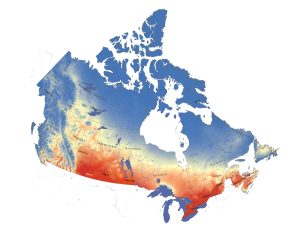Geographical Thinking
As teachers of geography, we strongly support and advocate for the inclusion of geographical teaching concepts in social studies classrooms across Canada. Geographical thinking should be embedded in provincial curricula in order to ensure all teachers are utilizing these skills. Teaching geography needs to be much more than the transference of information from teacher to student. Rather, through the utilization of geographical thinking and other critical thinking skills, geography classes are an opportunity for student transformation through skills that can be applied throughout their lives as they understand and create their own sense of place. Most educators understand that while the content of geography (the location of places, their features, the ways humans interact with their environment) are important, it is much more meaningful when students interpret, analyze and research geographical information themselves rather than just receive the information. Students should see themselves as agents in the process of learning.
The authors of Teaching Geographical Thinking (Editor: Roland Case) provide a professional resource to help teach six interrelated concepts central to students’ ability to think critically about geography. Their work at the University of Calgary developed a geographical thinking framework that revolved around six thinking concepts. Globally, there are alternative approaches to this work, but Canadian curricula has, to varying degrees, been guided by it.
Geographical importance
The fir st of these concepts is geographical importance. Employing this concept involves asking students which geographic phenomena and locations are worthy of attention? Students must evaluate the features, or aspects of geographic phenomena, to determine what makes them worthy of attention or recognition. How landforms occur and how they shape the human uses of these places, changes to weather patterns and the role human activity may have in these phenomena, and the distribution of extreme weather events are all topics that benefit from employing a focus on geographical importance.
st of these concepts is geographical importance. Employing this concept involves asking students which geographic phenomena and locations are worthy of attention? Students must evaluate the features, or aspects of geographic phenomena, to determine what makes them worthy of attention or recognition. How landforms occur and how they shape the human uses of these places, changes to weather patterns and the role human activity may have in these phenomena, and the distribution of extreme weather events are all topics that benefit from employing a focus on geographical importance.
Evidence and interpretation
The second concept is evidence and interpretation. Students are expected to use geographic inquiry processes and geographic literacy skills. In so doing they ask questions about, and gather, interpret, and analyze data and ideas from a variety of sources and spatial/temporal scales. The interpretation of evidence is assessed taking into consideration contentious issues, source reliability, and the adequacy of the evidence. For example, these skills are essential in studying controversial environmental issues such as pipeline development or gentrification of city neighbourhoods.
Identifying patterns and trends
 Identifying patterns and trends is the third concept and is useful for looking at consistencies in geographic phenomena over time and space. This means students must draw conclusions about the variation and distribution of geographic phenomena by comparing information from one place to another with respect as well to how the phenomena change, or repeat, over time. They should also note the way natural phenomenon vary in consistency in a specific place over time. Examples of study could include the Ring of Fire and its impacts throughout this region or at a specific locale, or the impact of urban growth on soil erosion, the water cycle, and agricultural land.
Identifying patterns and trends is the third concept and is useful for looking at consistencies in geographic phenomena over time and space. This means students must draw conclusions about the variation and distribution of geographic phenomena by comparing information from one place to another with respect as well to how the phenomena change, or repeat, over time. They should also note the way natural phenomenon vary in consistency in a specific place over time. Examples of study could include the Ring of Fire and its impacts throughout this region or at a specific locale, or the impact of urban growth on soil erosion, the water cycle, and agricultural land.
Interactions and associations
The fourth concept is focused on interactions and associations. When we examine geographical phenomenon in the context of human society, we need to explore the impacts we have on the natural landscapes and conversely adapt to those landscapes. Through this lens we explore such things as modification to the lithosphere by resource extraction or settlement patterns associated with these resources. By going beyond simply knowing where places are, exploring how things are associated and interact provides context for a broader understanding of the geographic phenomenon.
Sense of place
A sense of place is the next concept. This involves gaining an understanding of the different attributes surrounding a place. As teachers ask students to put themselves in the position of an observer and to become more aware of their spatial experiences, we are encouraging much more connection and understanding of their community and environment. Students develop the ability to assess the importance and uniqueness of places by identifying their physical and/or human features, and delineating areas of regional differentiation for the purpose of mapping.
Geographical value judgments
 The final concept is geographical value judgments. The expectation is that we make reasoned ethical judgments about controversial actions in the past or present, and determine whether we have a responsibility to respond, such as is the case with environmental problems. What ethic drives our actions or responses to the geographic phenomena? Students should be able to evaluate how particular geographic actions or events affect human practices or outcomes. For example, should people sacrifice some of their standard of living to halt global climate change?
The final concept is geographical value judgments. The expectation is that we make reasoned ethical judgments about controversial actions in the past or present, and determine whether we have a responsibility to respond, such as is the case with environmental problems. What ethic drives our actions or responses to the geographic phenomena? Students should be able to evaluate how particular geographic actions or events affect human practices or outcomes. For example, should people sacrifice some of their standard of living to halt global climate change?
Conclusion
Teachers engaging students in geographical thinking through critical inquiry will find these six geographical thinking skill areas provide a framework for geographical problem-solving. Teachers challenge students to be aware of and understand their environment, whereby they establish their own sense of place, while contemplating the varied perspectives on human/environmental interrelationships. Teachers encouraging student agency, having them see themselves as part of the process of learning about their world, is essential in the social studies classroom. The geographical thinking concepts support this.
